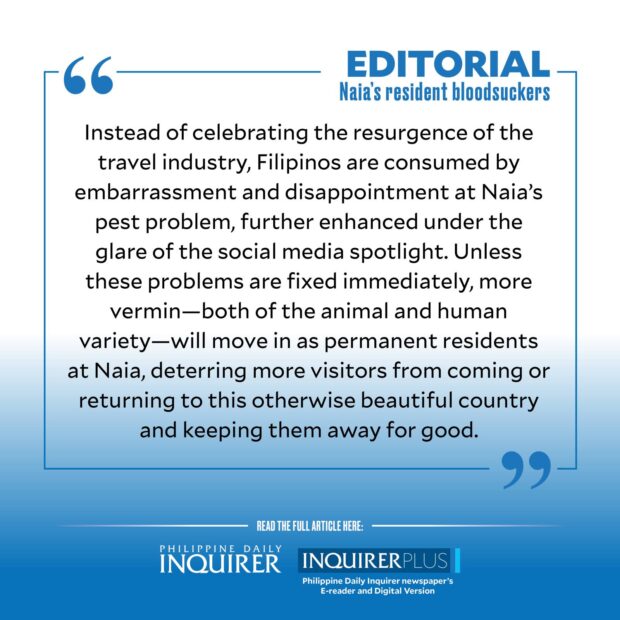Naia’s resident bloodsuckers

The obvious joke, of course, is that life in the Philippines has become so awful even the local “surot” or bedbugs are making a beeline for the airport to hop off to greener pastures abroad.
Then again, the invasive bloodsuckers sighted at Terminals 2 and 3 of the Ninoy Aquino International Airport (Naia) might actually have been “imported” into the country, being larger than the kind found here, as one airport official noted in a media report.
Then came another conjecture, courtesy of a House lawmaker, who said last week that the bedbugs, as well as cockroaches and rats spotted in the same areas, could have been deliberately placed there to sabotage the administration in a nefarious “tanim peste (pest planting)” conspiracy, a stranger-than-life mutation of the “tanim bala (bullet planting)” scandal of years ago.
Article continues after this advertisementWhichever the case, those pests surely deserve our sympathies for enduring the indignity of being plucked out of their homes only to wind up at Naia, one of the most unpleasant places for the poor critters and passengers alike.
A laughingstock
As always, reality is funnier than the best punchline, but the joke is on the Philippines’ main gateway to the world. That Naia is now a laughingstock among travelers both foreign and Filipino is, to put it lightly, not a new development, and the viral videos of bedbugs and other pests at the airport are only the newest eggs to land on its face, prompting an internal review of its housekeeping and pest control service providers.
Last week, Manila International Airport Authority general manager Eric Ines warned the contractors they could be blacklisted and reminded them of accountability clauses in their service agreements.
Article continues after this advertisementBy March 1, the airport was declared free of surot.
To be fair, bedbug infestation isn’t strictly caused by sanitation or hygiene problems. According to the Mayo Clinic, bedbugs “don’t care if their environment is clean or dirty. All they need is a warm host and plenty of hiding places.”
World’s worst airport
Even Paris, host of the 2024 Olympics, was widely reported to have been contending with a bedbug outbreak, although one French minister recently accused Russia of artificially amplifying the scare to embarrass France. Alas, in Naia’s case, there’s not much room for it to be of any greater embarrassment to the Philippines than it already is.
In February, it was ranked the fourth worst airport in Asia in an online survey of business travelers, with an average rating of only 2.78 on a scale of 1 to 10. In terms of passenger queuing, the Manila airport was the eighth worst in Asia, based on another study in August last year.
For sure, there has been improvement, considering Naia was twice declared the world’s worst airport, in 2011 and 2013, and Asia’s worst in 2012, by the Sleeping in Airports travel website, going up in rank in the years since.
P170.6 billion project
But seemingly endless controversies surrounding Naia and the agencies operating within its premises, including immigration, aviation, and transport security, have continued to drag its name through the mud.
Who can forget the power outages that downed air navigation facilities and canceled hundreds of flights on New Year’s Day last year? Or the airport screening officer caught on camera swallowing $300 in cash pilfered from a tourist in September 2023? Or immigration officers’ ridiculous demand on outbound passengers to produce documents like their college yearbook as proof of identity?
Granted, not all of these are within the purview of Naia management, but they all add to the airport’s notoriety anyway. Perhaps, more than insects and rodents, the people behind these fiascoes should be evicted instead.
The work is thus cut out for the San Miguel Corp.-led consortium to rehabilitate not just Naia’s physical facilities but its human resources, too, as it takes over airport operations in the latter part of the year after winning the coveted P170.6 billion project. In February, Transportation Secretary Jaime Bautista said the consortium should be able to upgrade passenger experience at Naia by 2025.
But travelers shouldn’t have to wait that long.
Resurgence of travel industry
Data from the Civil Aeronautics Board showed that passenger volume for both domestic and international flights reached 50.18 million last year, soaring by 55 percent from 32.33 million in 2022, numbers not seen since before the pandemic.
Clearly, people are coming in and going out of Manila’s premier airport in bigger droves than ever.
But instead of celebrating the resurgence of the travel industry, Filipinos are consumed by embarrassment and disappointment at Naia’s pest problem, further enhanced under the glare of the social media spotlight.
Unless these problems are fixed immediately, more vermin—both of the animal and human variety—will move in as permanent residents at Naia, deterring more visitors from coming or returning to this otherwise beautiful country and keeping them away for good.
















